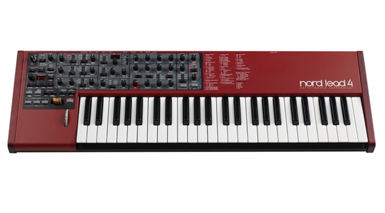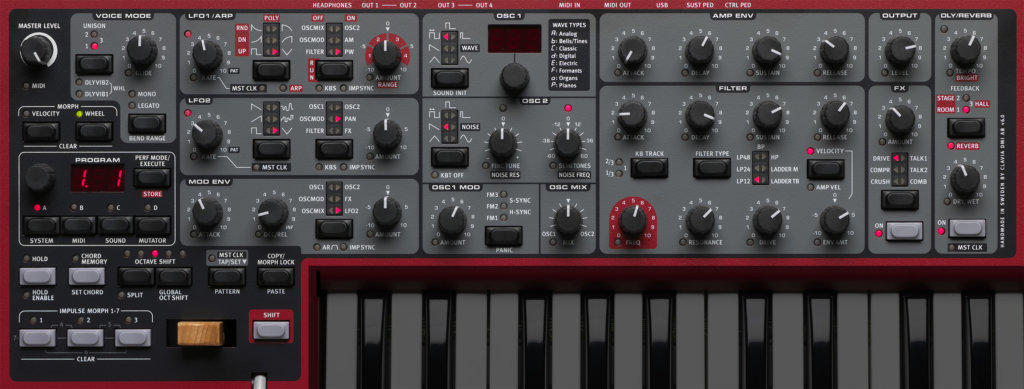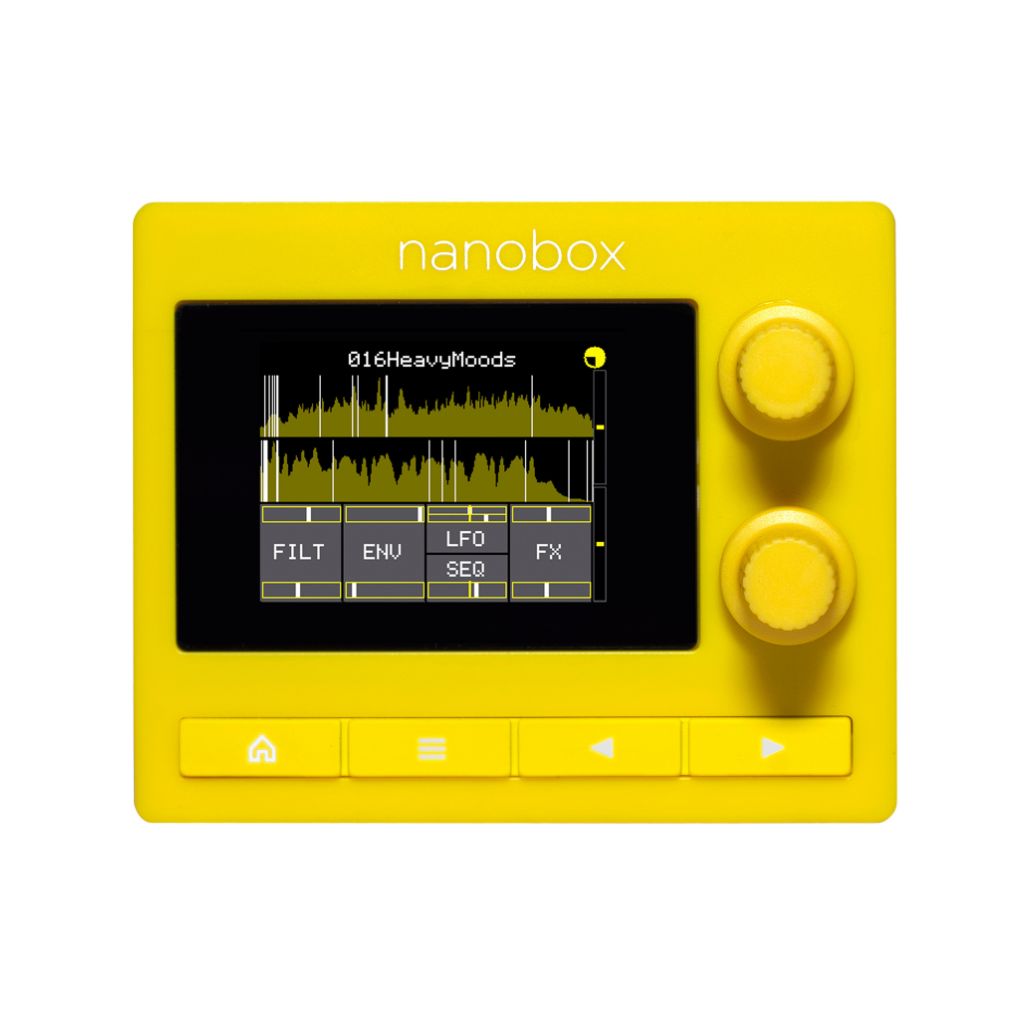Nord Lead 4 Review – Take The Lead
The classic lineage of Nord Lead synths gets a new member. But can it really improve on what’s gone before? Andy Jones has the answers in this exclusive Nord Lead 4 review… Details Manufacturer: Nord Price: £1549 Contact: Sound Technology – 01462 480000 Website: www.nord.com Amazon.co.uk Widgets It has got to be close to two […]

The classic lineage of Nord Lead synths gets a new member. But can it really improve on what’s gone before? Andy Jones has the answers in this exclusive Nord Lead 4 review…

Details
Manufacturer: Nord
Price: £1549
Contact: Sound Technology – 01462 480000
Website: www.nord.com
It has got to be close to two decades since I reviewed the original Nord Lead synth. I remember three things that struck me: it was red (a first for the time), and it sounded superb, especially given that it was digital. Indeed it was such a highlight in the then virtual analogue world that we took the thing apart just to check it was digital which led to that third recollection: a hollow keyboard with a couple of printed circuit boards lying beneath the controls on the left hand side. Yep, very definitely digital…
Since then the Nord Lead has been through a few incarnations. The follow up Nord Lead 2 took the synth’s polyphony up from four to 16 notes. The Nord Lead 3 added extra synthesis, an arpeggiator and, most importantly to my eyes, the iconic rotary knobs with LEDs that lit as you turned them. Absolutely mesmerizing and surely the best invention in music technology… ever! However, its price and component issues meant that Clavia eventually discontinued it in favour of an updated 2X that has 20 voices of polyphony and a synth that remains on sale to this day.
The impact of the Nord Lead range of synths cannot be understated. They have remained beacons in the virtual analogue world, highly regarded by many as being the ‘closest to the real thing’ you can get. I know the following is not exactly scientific proof of the synth’s success, but in the intervening years I have carried out many hundreds of interviews with all sorts of producers, engineers and musicians and that distinctive red keyboard (or module) has been more present than any other synth.
Four by Four
And so, on Clavia’s 30th anniversary, we arrive at the Nord Lead 4, the product of this year’s Frankfurt (if you judge ‘products of shows’ at how busy the company stands were anyway). On paper you might think it’s veering back towards the 3 with its on-board arpeggiator but, first up, it doesn’t have the rotary lights. Nooooooooooo! But perhaps it’s a little unfair to judge it against that synth and look at it more against the current 2X. It equals that synth’s 20 notes of polyphony and four parts multitimbrality and has a similar number of programs (4×99) and performances (99), but adds a lot, lot, more…
Firstly the main sound engine has been revamped and built on a new DSP platform with 2x oversampling. The synth engine is still based on virtual analogue (two oscillators) and FM synthesis but has been beefed up with 128 wavetables, and an additional two modes of FM (making three in total). There are additional filters including a dedicated filter overdrive for extra distortion and a Transistor Ladder and Diode Ladder, labelled ‘Ladder M’ and ‘Ladder TB’. This becomes exciting when you realise the ‘M’ stands for Moog and the ‘TB’ stands for TB-303. There are more effects and the aforementioned arpeggiator which, along with the LFO and effects, can be sync’d to the master clock.
The Nord Lead 4 is also aimed more at the live player so has many new real-time performance additions including Impulse Morph. This rather futuristically named feature allows you to get inside a sound and alter many of its parameters instantly and is an additional feature to Morph which has existed for a while now. The Morph feature is still present and correct on the 4 and, while it allows several parameters to be adjusted in real time by way of the mod wheel, pedal or note velocity, the new Impulse Morph feature allows instant switching between these parameters with the flick of a switch and seven times! Read more about how this works in practice in the box on p**.
Also on the live side of things are Patterns (128 in total over seven categories) that can be assigned to the arpeggiator and LFOs. The arpeggiator itself is not just your average note by note one either. Four can be played simultaneously over four slots and the poly mode enables chordal arpeggiations to be played. Again, more on this later.
So far so very Jean Michel Jarre. On paper this already sounds like a swirling, pumping, morphing and massively layered synth that should fulfill the electric dreams of even the biggest synth head. Time to get in there…

Slot Machine
The Nord Lead 4 has four sound ‘slots’ each representing, as the manual says, ‘a complete synthesizer set-up’ with its own set of two oscillators and LFOs; modulation and amp envelopes, and multi-type filter section. So basically this means it’s a four part multi-timbral synth and one with two familiar modes. In Program Mode, you play one sound within a single slot chosen from the four banks of 99 program sounds. You can also have four programs triggered by different MIDI channels across all four slots or simply split them across the keyboard or layer them together to build bigger complex sounds in Performance Mode which accesses all four slots. Here you get 99 performances but let’s look at the individual program sounds which make them up…
There are actually three banks of 99 programs as the fourth is identical to bank 1 and designed as the place to store your own sonic creations. As to the sounds, as you might expect with a keyboard of this generation and version number, the quality has been refined and the new sound engine is clean and punchy across the board. What will strike you, though, is the variety of the sounds on offer. From memory the original really did concentrate on recreating analogue but this is a different beast altogether. The additional forms of synthesis – with those Wavetables and extra FM modes – help make up a breathtaking range of sounds, from the obvious analogue through to emulations of acoustic instruments to frankly ‘out there’ sounds which will have you playing them just to work out what they are. Indeed one of them initially seemed to be vinyl noise until I realized that there was more going on as its digital sources emerged. It’s nice to see a company famed for its excellent ‘proper’ keyboard sounds, as found in its superb Stage and Piano ranges, pushing the sonic envelope so much here.
Many of the programs have extreme velocity settings too so playing quietly will give you a dramatically different result to slamming the keys. Some of the sounds have a great biting dirt with noise added to appeal to lovers of more, well, filthy genres of music. A lot of this extra dimension is down to the new effects which include a bit crusher, drive circuit, vocoder-like (Talk 1 and 2) and a compressor which are very easy to change, add or remove.
Not surprisingly the ‘analogue’ side of the Nord Lead 4 is full of greatness with the TB and Mini filter emulations in evidence on many programs. Others are also armed with the arpeggiator or Morph parameters for instant impressiveness. This leads to many of the analogue style presets having huge amounts of movement and you want to stay with them, latch them, and get twiddling. The additional FM modes give you all the bells and whistles that that synthesis method adds with lots of percussive and acoustic type presets, but have enough years passed to bring back 80s style DX pad sounds? It appears so!
Ultimately then, it’s hard not to say ‘something for everyone’ as there is plenty that will appeal to many musicians within several musical genres, but electronica is the hands down winner as far as the sounds go – this is a proper synth through and through. However that’s by no means the end of the story. Let’s start playing…
[soundcloud url=”http://api.soundcloud.com/playlists/4636277″ params=”” width=” 100%” height=”450″ iframe=”true” /]
Live Play
When it comes to the Performance Mode the 99 presets are big, in your face or just sheer quality. Many of the split Performances have a pulsing bass arpeggiation at the lower end of the keyboard with a different lead sound at the top so you can get moving in a big synthy stylee. Others ramp up the techno stakes with beats, basslines and leads to make complete tunes on the fly. There are rather too many of these for my liking – I’m old school, as I prefer my drums to come from a separate machine or a sample – and I can’t help thinking they might date the machine quite quickly, but other performances work very well, from the more simple layered electric piano sounds to some of the quirkier electronic combinations. And it’s easy to edit and make your own combinations anyway, so there’s plenty worth exploring here.
The new arpeggiator features are another performance aspect well worth spending a bit of time on. You get the usual octave shift plus up, down and random patterns, but there are a couple of additions that take this section well beyond the norm. The first is Poly Mode which arpeggiates the complete chords you play, not just the notes, which is great for more complex movement. Then there’s Pattern Mode which enables you to choose different patterns to play within your arpeggiator. These are more complex and based on six different pattern types including Groove and Back Beat. If you tie these in with the Impulse Morph feature (see box) you can quickly trigger seven different pattern types one after each other in an instant. It’s an extra layer which again takes Nord Lead 4 up a level. Last but not least all of these can be sync’d to the master clock, sped up and slowed down with the LFO1 rotary or sync’d externally. All sorts of rhythmic shenanigans to be had here then…
Focus On – The Mutator
I’d done a fair bit of research on the Nord Lead 4 before switching it on and the Mutator, on paper, was one of the things that I was most intrigued about. Basically it’s a program or sound generator. Dial up any program, or initialise a preset back to its basic components, enter Mutator and you can instantly program new sounds based on the original. When I say ‘based on’, this is only part of the story. You can choose a ‘Variation’ of the original sound (option A) and a ‘Process strength’ of between 1 and 5 with 5 giving you the most dramatic Variation. If you keep pressing Execute you will get another variation of the original sound. Keep going until you get a sound you are happy with, save it, and you are now a synth programmer!
Mutation (option B) again gives you the process strength option but this time pressing Execute gives you a Mutation of the last time you did it rather than a variation of the original sound, so constantly pressing Execute soon takes your new sound into very different territories compared to the original. Finally a random option and strength offers, well, random sounds.
This Mutator section really is terrific fun and very easy to use. If you try it out, you will have that bank of user locations filled in no time.
Take Hart
Impulse Morph adds to the very interesting Nord Lead Morph feature that allows multiple sound parameters to be controlled from Morph sources: mod wheel and pedal, and keyboard velocity. The concept of Morphing was a little hard for my old brain to get around at first so if you are struggling, let me give you a quick and easy example. Imagine you dial up a simple, non Morphed bass sound on the Nord Lead 4. Now press and hold the Wheel button within the Morph section. This gives you access to all the front panel controls so simply rotate any dials that you want the mod wheel to change and it will, simple as that!
That’s Morphing but what about Impulse Morphing, the new Nord Lead 4 feature? You’ll find the Impulse Morph buttons next to the pitch bend stick (which is distinctively familiar to any Clavia owners). Impulse Morphs instantly change several parameters of a sound – up to 36 destinations and 21 switches – just by hitting one of these. So, mid performance, you can easily change your oscillator type, push your frequency rate up, adjust the amp envelope or add effects to a sound, and all done in an instant.
Setting up an Impulse Morph is easy. Simply dial up any program and press one of the seven Impulse Morph combinations and dial any parameter you want to change. Any editor parameters show as green LEDs. Seven variations are available per slot which means seven times the fun as you are effectively getting access to seven – either subtly or very dramatically – different versions of the preset program you are playing which ultimately gives you a crazy amount of live real-time and instant changes at your fingertips!
Conclusion
The preview buzz around the Nord Lead 4 was about its new sound engine, the Minimoog and TB filter emulations, and the arpeggiator with its new features. These have all lived up to the hype but it’s actually the Impulse Morphing and Mutator that excite me too – perhaps even more so! The former not only means a lot for the live player but adds a completely new dimension to the sounds on the synth. With up to seven variations of a program at your fingertips and then the ability to control so many parameters… Well it’s almost like looking at that photo of all of the galaxies that the Hubble telescope took – the possibilities are immense! Mutator too is a gem – program creation has never been so easy and so much fun.
So while the headline acts perform brilliantly it’s the support bands that really make the show for me, and even though I’ve had the synth for a couple of weeks I think I’ve only scratched the surface of its creative potential. And I’m surprised as just how versatile it sounds, how flexible it is and how easy such a many layered beast it is to use. But should I really be that surprised? It is, after all, the latest from a now classic range of synths which I’ve seen in the best studios across the land and is sure to join them there. What a year for hardware synths (and my poor wallet).
Verdict
+ Huge variety of sounds and synthesis engines
+ Excellent Impulse Morphing adds huge performance potential
+ Love the Mutator!
+ Powerful Arpeggiation and live features
+ Surprisingly easy to use considering the complexity
– Too many beats in Performance mode for my liking
Nord Lead 4 is an exceptional synth. 2013 is demonstrating that, not only is hardware still very much alive, but it’s kicking harder than ever.




